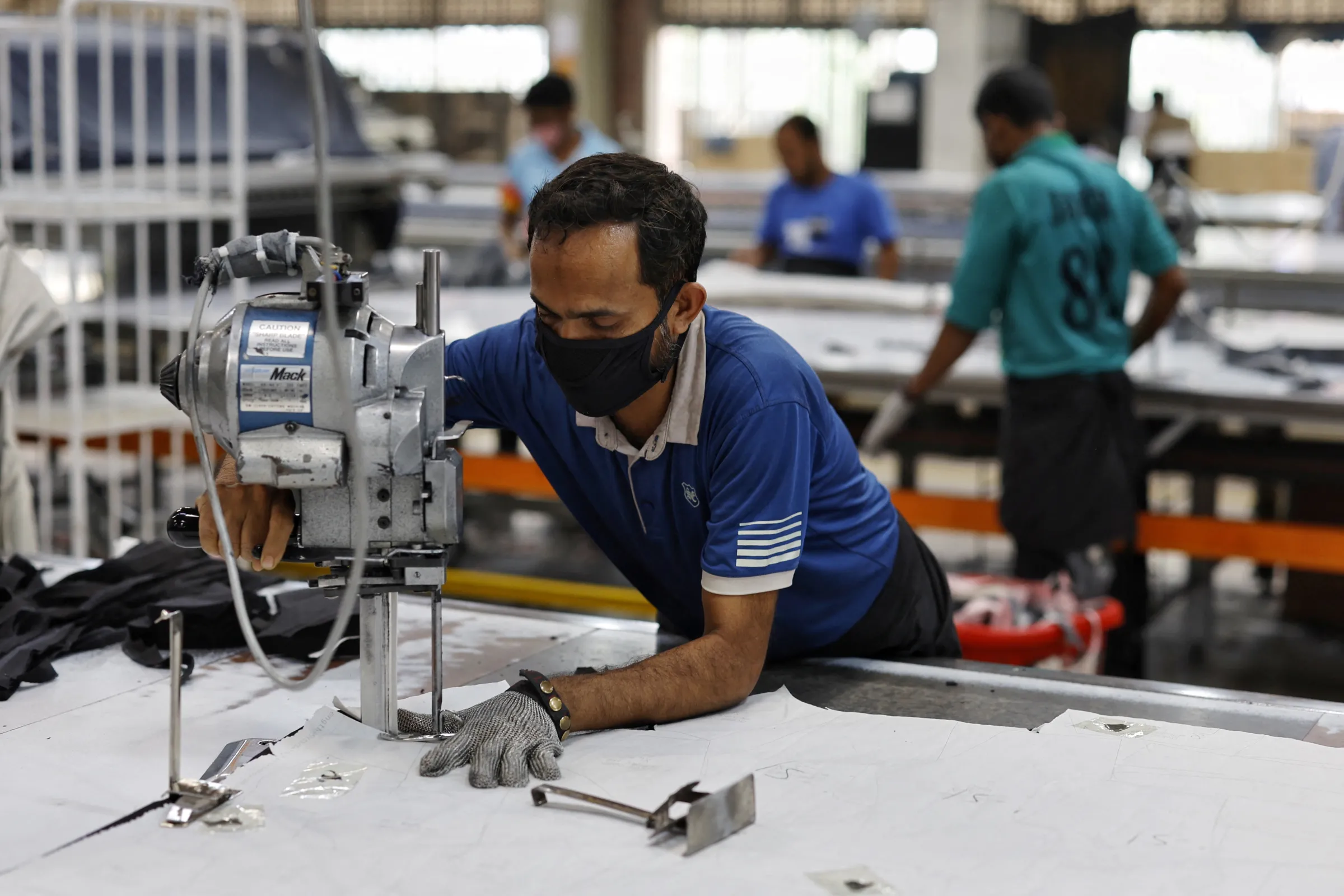Textile factories turn to smart tech to monitor worker output

A Bangladeshi garment worker uses cutting machine in the cutting section of a factory in Gazipur, Bangladesh, April 9, 2025. REUTERS/Mohammad Ponir Hossain
What’s the context?
Bangladeshi fashion suppliers adopt new technology to boost productivity. Workers want a fair share of the benefits.
- Smart devices track Bangladesh garment workers' output
- Managers collect live data on productivity, quality
- Union leader calls for greater share in benefits
SAVAR - Internet-connected smart devices and artificial intelligence are speeding up production in the garment-making factories of Bangladesh, the world's second largest fashion-producing country.
On the shop floor of 4a Yarn Dyeing, popular music blared from a sound system as women sewed clothes at machines equipped with sensors that track how many pieces each worker produced in real time.
The devices allow the factory's owner Team Group to compare output to workers' daily targets and remotely monitor every line on the factory floor, troubleshoot machine defects and use artificial intelligence to analyse productivity.
"While efficiency does not come overnight, you can eventually notch up performance with the real-time data," said Abdullah Hil Nakib, deputy managing director of Team Group, which started using the devices three years ago.
From designing clothes to speeding up marketing campaigns, global fashion is rapidly adopting new technology.
Generative AI alone could add $275 billion to global fashion's operating profits by 2028, a report last year by consultancy McKinsey & Company said.
But experts said using technology to make workers ever-more efficient should deliver them a better deal too.
Umme Hani, assistant professor at the School of Law and Business at Australia's University of Notre Dame, said AI can complement human skills and expertise, rather than merely tracking and controlling workers.
"If we don't take the right approach, we could see a growing tension between technology and labour rights, and quite frankly, that could escalate into a preventable crisis," she said.
Efficiency urgency
As Bangladesh prepares to move out of the U.N.'s least developed countries category next year, tariff concessions in key markets like the European Union will end.
Already, the Trump administration hiked U.S. tariffs on Bangladeshi imports earlier this year.
Bangladesh's apparel industry, which accounts for about 13% of the $450 billion economy and 85% of its exports, lags competitors in Vietnam and China in efficiency and quality, a 2022 study by the World Trade Organization and the United Nations showed.
To stay competitive, Bangladeshi clothing makers will have to invest in technology to improve efficiency, according to Dhaka-based think tank Research and Policy Integration for Development.
"There is no choice but to deploy AI-based algorithms in driving up efficiency and improving planning in the industry," said Oli Ahad, founder of Dhaka AI Lab, which works with the garment industry to integrate new technology.
Tech companies also claim that smart systems can reduce the use of natural resources by avoiding product defects.
What about workers?
Mosammat Aktar, who has worked in the garment industry for five years, said she would often forget whether she had reached her daily production target under a previous manual system.
"The new device, with its clock and counting system, helps us keep on track towards our targets," said Aktar, who was introduced to Context by a manager at the 4a Yarn Dyeing factory.

A Bangladeshi garment worker checks sewing quality as she works in the sewing section of a factory in Gazipur, Bangladesh, April 9, 2025. REUTERS/Mohammad Ponir Hossain
A Bangladeshi garment worker checks sewing quality as she works in the sewing section of a factory in Gazipur, Bangladesh, April 9, 2025. REUTERS/Mohammad Ponir Hossain
She added that workers do not get incentives tied to the smart monitoring of their performance.
Intellier, a Bangladeshi company that developed the technology that now monitors Aktar's work, has said the devices cut workers' idle time by up to 15%, which in turn could boost company profits by as much as 10%.
The next step will be building AI enhancements that give factories automated suggestions on workers' skill requirements, said Kahafil Ora, head of business at Intellier.
But unions want textile companies to do more than simply retrain workers to meet new production targets.
More than 4 million people work in Bangladesh's textile industry, where the monthly minimum wage is 12,500 taka ($103).
Factories with smart monitoring systems should reinvest the windfall they stand to gain in their employees, said SM Ahasan Habib Bulbul, president of Garment Workers' Front, a trade union federation.
"That should include raising the workers' pay to help them afford better food and housing - or using digital technology to care for their mental health," Bulbul said.
($1 = 121.25 taka)
(Reporting by Md. Tahmid Zami; Editing by Jack Graham and Ayla Jean Yackley.)
Context is powered by the Thomson Reuters Foundation Newsroom.
Our Standards: Thomson Reuters Trust Principles














